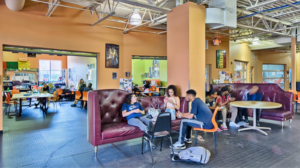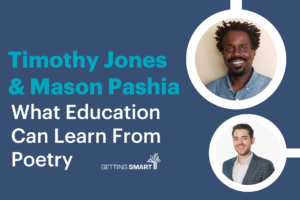New Pathways Design Principles

On this special series of the Getting Smart Podcast, Shawnee Caruthers is joined by New Pathways Senior Fellow Timothy Jones to discuss each of our four New Pathways Design Principles: Inetional, Equitable, Purposeful and Curated. When designing pathways, they must “help learners identify strengths and interests and match them with possible futures. With a growing sense of purpose, learners spot opportunities and develop an entrepreneurial mindset.”
This series unpacks what must be present to create experiences that truly work for and with learners.
Why Are Pathways Necessary?
Across the nation, leading institutions and organizations are identifying pathways as a core component of a thriving economy and a missing piece from the K-12 experience. Alongside American Student Assistance, the Bill & Melinda Gates Foundation, the Walton Family Foundation, and Stand Together we are investigating how to better embed pathways to help all learners find success in what’s next.
We know a few things to be true:
1. Most teens leave high school unprepared for what’s next. Prepandemic, most colleges reported that students were not ready for college-level work. The pandemic made the college preparation gap worse. Most teens are not leaving high school job ready either. There are about 11 million jobs open in America — the result of a complicated COVID overhang and new economy labor shortage.
Takeaway: New pathways are meaningful sequences of learning experiences linked to opportunity. The result in experiencing success in what’s next: real work experience, college credit, and industry-recognized credentials.
2. Many students are not engaged in school. A recent YouthTruth Survey found that about 60% of high school students are engaged. Only 52% said they enjoy coming to school and 48% said what they are learning in school helps them outside of school. The pandemic increased trauma, hopelessness, and dissatisfaction with traditional education, particularly rote one-size-fits-all learning.
A new Populace study found that “Americans do not care if all students study the same thing compared to them getting to choose courses based on their individual interests.” They also found that “Americans prefer an education system where all students receive the unique supports that they need throughout their learning and all students get whatever amount of time they need to learn a new concept or skill at their own pace.” Also, “Americans want to grant more control to students themselves, prioritizing a K-12 education where all students have the option to choose the courses they want to study based on interests and aspirations.”
Takeaway: New pathways are co-authored experiences and journeys with personalized and localized guidance and support.
3. Most teens feel unprepared for postsecondary decisions. A recent survey suggests that three-quarters of students feel less than prepared to make college and career decisions. Nearly half of those starting college leave without a credential. This suggests bad-fit decisions and results in the new worst-case scenario of debt without a degree.
Takeaway: New pathways help learners identify strengths and interests and match them with possible futures. With a growing sense of purpose, learners spot opportunities and develop an entrepreneurial mindset.
4. More opportunities for some. The loss of traditional jobs during the pandemic and the rise of the platform economy boosted business starts to more than 5 million in 2021 and 2022 (double the rate of 10 years ago). An Adobe survey found that about 45% of Gen Z creators surveyed said they aspire to own a business and make money from content shared online. And, While millennials are experimenting with having a side hustle alongside a day job, “Gen Z is focused more on making a project into a career,” said Maria Yap, Vice President at Adobe. “They’re thinking, no — my regular job could be the thing that I’m passionate about.”
Teens have more opportunities than ever to explore possible futures, enter employment, and make a contribution using smart tools, but the visibility and access to opportunity are not equitably distributed. Social capital remains a huge obstacle to spotting and accessing opportunity for many learners.
Takeaway: New pathways provide equitable accessible, meaningful accommodation and support the development of social capital needed to access opportunity.
Or to put it more succinctly, the problems above point to each of the four design principles we have instituted for this campaign:
| Problems | New Pathway Design Principles |
| Low levels of college and work readiness | Intentional: a meaningful sequence of powerful learning experiences back mapped from opportunity. Learners experience success in what’s next: real work experience, college credit, and industry recognized credentials |
| Low engagement, low depth of knowledge | Curated: co-authored experiences and journeys |
| Lack of direction | Purposeful: identify strengths, interests, and values; spot opportunities and deliver value (entrepreneurial mindset) with personalized and localized guidance |
| Opportunity is uneven | Equitable accessibility & accommodation, support & social capital |




0 Comments
Leave a Comment
Your email address will not be published. All fields are required.